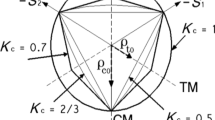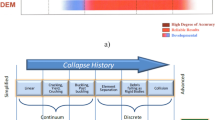Abstract
An extreme loading on a reinforced concrete frame leads to severe increase in cracks in concrete as well as large strains in reinforcing bars. This, in turn, results in reduction of steel–concrete bond as well as an increase in the subsidiary effects of slip. In the current study, to include the slip effects in the numerical analyses, an indirect approach based on the results of pull-out test modeling is proposed. The proposed approach suggests a steel strength-reduction factor of 0.6 so as to apply to the bars prone to slip. This value is obtained based on the results of micro-modeling of available experimental pull-out tests using ABAQUS. To account for the bond-slip effect between concrete and rebar, adjacent nodes of concrete and rebar were connected using nonlinear springs. To estimate the length of slip prone zone, a sensitivity analysis on the collapse behavior of two reinforced concrete sub-frames from a 10-story building was conducted. The experimental data for the sub-frames were available. Corroborated with the experimental data revealed that if the length of the slip prone zone is considered to be twice the depth of the beam, the presented indirect approach will be capable of predicting the load–deformation response with a good accuracy. The obtained results showed the significance of considering slip effect in the analyses of reinforced concrete frames as well.

























Similar content being viewed by others
References
Sasani M, Werner A, Kazemi A (2011) Bar fracture modeling in progressive collapse analysis of reinforced concrete structures. Eng Struct 33:401–409. https://doi.org/10.1016/j.engstruct.2010.10.023
Fernandes C, Varum H, Costa A (2013) Importance of the bond–slip mechanism in the numerical simulation of the cyclic response of RC elements with plain reinforcing bars. Eng Struct 56:396–406. https://doi.org/10.1016/j.engstruct.2013.05.013
Mousavi SS, Dehestani M (2015) Implementation of bond-slip effects on behavior of slabs in structures. Comput Concr 16:311–327. https://doi.org/10.12989/cac.2015.16.2.311
Dehestani M, Mousavi SS (2015) Modified steel bar model incorporating bond-slip effects for embedded element method. Constr Build Mater 81:284–290. https://doi.org/10.1016/j.conbuildmat.2015.02.027
Ngo D, Scordelis AC (1967) Finite element analysis of reinforced concrete beams. ACI Struct J 64:152–163. https://doi.org/10.14359/7551
Ibrahimbegovic A, Boulkertous A, Davenne L, Brancherie D (2010) Modeling of reinforced-concrete structures providing crack spacing based on XFEM, EDFEM and novel operator split solution procedure. Int J Numer Methods Eng 83:452–481. https://doi.org/10.1002/nme.2838
Ibrahimbegovic A, Boulkertous A, Davenne L, Muhasilovic M, Porkrklic A (2010) On modeling of fire resistance tests on concrete and reinforced-concrete structures. Comput Concr 7(4):285–301. https://doi.org/10.12989/cac.2010.7.4.285
Rubiano-Benavides NR (1998) Predictions of the inelastic seismic response of concrete structures including shear deformations and anchorage slip. Ph.D. Dissertation, University of Texas, Austin
Casanova A, Jason L, Davenne L (2012) Bond slip model for the simulation of reinforced concrete structures. Eng Struct 39:66–78. https://doi.org/10.1016/j.engstruct.2012.02.007
Qian B, Li B, Zhang ZW (2014) Testing and simulation of 3D effects on progressive collapse resistance of RC buildings. Mag Concr Res. https://doi.org/10.1680/macr.14.00178
de Terán JRD, Haach VG (2018) Equivalent stress-strain law for embedded reinforcements considering bond-slip effects. Eng Struct 165:247–253. https://doi.org/10.1016/j.engstruct.2018.03.045
Yang Z, Liu Z, Xiong Y, Li M (2018) Three-dimensional finite-element analysis of bond-slip behavior between crescent ribbed bar and concrete based on spring element. J Mater Civ Eng. https://doi.org/10.1061/(ASCE)MT.1943-5533.0002260
Feng DC, Xu J (2018) An efficient fiber beam-column element considering flexure–shear interaction and anchorage bond-slip effect for cyclic analysis of RC structures. Bull Earthq Eng 16:5425–5452. https://doi.org/10.1007/s10518-018-0392-y
Rashidian O, Abbasnia R, Ahmadi R, Mohajeri Nav F (2016) Progressive collapse of exterior reinforced concrete beam–column sub-assemblages: considering the effects of a transverse frame. Int J Concr Struct Mater 10:479–497. https://doi.org/10.1007/s40069-016-0167-2
Bao Y, Kunnath SK, El-Tawil S, Lew HS (2008) Macromodel-based simulation of progressive collapse: RC frame structures. J Struct Eng 134:1079–1091. https://doi.org/10.1061/(ASCE)0733-9445(2008)134:7(1079)
Yu J, Tan KH (2011) Experimental and numerical investigation on progressive collapse resistance of reinforced concrete beam column sub-assemblages. Eng Struct 55:90–106. https://doi.org/10.1016/j.engstruct.2011.08.040
Kwak HG, Kim JK (2006) Implementation of bond-slip effect in analyses of RC frames under cyclic loads using layered section method. Eng Struct 28:1715–1727. https://doi.org/10.1016/j.engstruct.2006.03.003
Limkatanyu S, Spacone E (2002) Reinforced concrete frame element with bond interfaces. I: displacement-based, force-based, and mixed formulations. J Struct Eng 128:346–355. https://doi.org/10.1061/(ASCE)0733-9445(2002)128:3(346)
Kang SB, Hai Tan K (2016) Bond–slip behavior of deformed reinforcing bars embedded in well-confined concrete. Mag Concr Res 68:515–529. https://doi.org/10.1680/jmacr.15.00245
BaniAsad E, Dehestani M (2019) Incorporation of corrosion and bond-slip effects in properties of reinforc0ing element embedded beams. Structures 20:105–115. https://doi.org/10.1016/j.istruc.2019.03.004
Ruiz MF, Muttoni A, Gambarova PG (2007) Analytical modeling of the pre-and post-yield behavior of bond in reinforced concrete. J Struct Eng 133:1364–1372. https://doi.org/10.1061/(ASCE)0733-9445(2007)133:10(1364)
Degroot AK, Kusters GMA, Monnier T (1981) Numerical modelling of bond slip behavior. In: NASA STI/Recon technical report no. 82
Ciampi V, Bertero VV, Popov EP, Eligehausen R (1981) Analytical model for deformed bar bond under generalized excitations. In: Proceedings of IABSE colloquium on advanced mechanics of reinforced concrete. Delft, pp 53–67
Hibbitt, Karlsson and Sorensen Inc. (2002) Abaqus/Standard users’ manual (Version 6.3). Dassault Systemes Simulia Corp., Pawtucket, RI
Haskett M, Oehlers DJ, Mohamed Ali MS (2008) Local and global bond characteristics of steel reinforcing bars. Eng Struct 30:376–383. https://doi.org/10.1016/j.engstruct.2007.04.007
Comité Euro-International du Béton (CEB) (1993) CEB–FIP model code 1990: model code for concrete structures. Thomas Telford, London
CEB (2010) CEB-FIP model code 2010. Thomas Telford, London
Lew HS, Bao Y, Pujol S, Sozen MA (2014) Experimental study of reinforced concrete assemblies under column removal scenario. ACI Struct J 111:881–892. https://doi.org/10.14359/51686739
Committee ACI (2005) Building code requirements for structural concrete (ACI 318-05) and commentary (ACI 318R-05). American Concrete Institute, Michigan
Lubliner J, Oliver S, Oñate E (1989) A plastic-damage model for concrete. Int J Solids Struct 25:299–326. https://doi.org/10.1016/0020-7683(89)90050-4
Fortunato G, Funari MF, Lonetti P (2017) Survey and seismic vulnerability assessment of the Baptistery of San Giovanni in Tumba (Italy). J Cult Herit 26:64–78. https://doi.org/10.1016/j.culher.2017.01.010
Ombres L, Verre S (2019) Flexural strengthening of RC beams with steel-reinforced grout: Experimental and numerical investigation. J Compos Constr 23:04019035. https://doi.org/10.1061/(ASCE)CC.1943-5614.0000960
Rasouli M, Broujerdian V (2019) 3D finite element modeling of FRP-confined rectangular short columns considering variation of Poisson’s ratio. Iran J Sci Technol Trans Civ Eng. https://doi.org/10.1007/s40996-019-00276-w
Hsu HS, Hsu CTT (1994) Complete stress-strain behavior of high-strength concrete under compression. Mag Concr Res 46:301–312. https://doi.org/10.1680/macr.1994.46.169.301
Nayal R, Rasheed HA (2006) Tension stiffening model for concrete beams reinforced with steel and FRP bars. J Mater Civ Eng 18:831–841. https://doi.org/10.1061/(ASCE)0899-1561(2006)18:6(831)
Author information
Authors and Affiliations
Corresponding author
Rights and permissions
About this article
Cite this article
Mohemmi, M., Broujerdian, V. & Rajaeian, P. An Equivalent Method for Bar Slip Simulation in Reinforced Concrete Frames. Int J Civ Eng 18, 851–863 (2020). https://doi.org/10.1007/s40999-020-00507-6
Received:
Revised:
Accepted:
Published:
Issue Date:
DOI: https://doi.org/10.1007/s40999-020-00507-6




